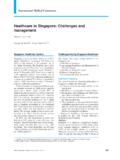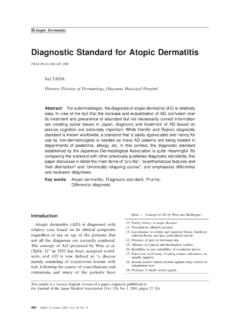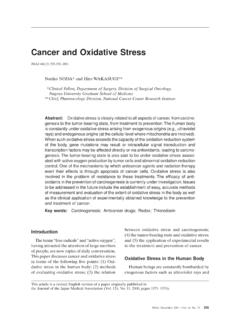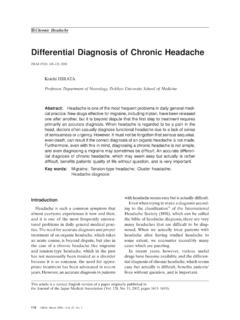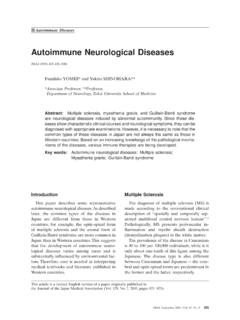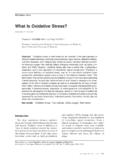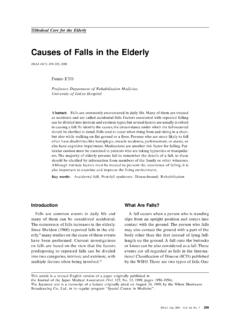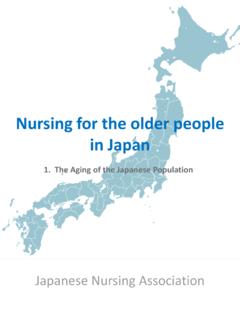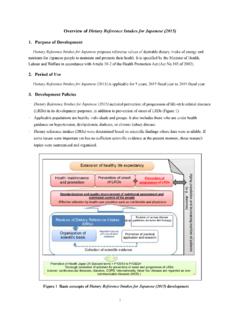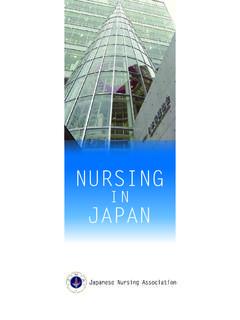Transcription of Healthy Japan 21 - Med
1 JMA Policies Healthy Japan 21. JMAJ 46(2): 47 49, 2003. Hideya SAKURAI. Executive Board Member, Japan Medical Association Key words: National health promotion; Life-long health project;. Investment in health from the permanent vice-minister for health Background of New Concepts and welfare entitled National Health Promo- The Ministry of Health and Welfare (cur- tion Movement in the 21st Century ( Healthy rently the Ministry of Health, Labor and Wel- Japan 21) on March 31, 2001. The Ministry fare) has been working to prepare infrastruc- selected as targets of the Tertiary National ture that will enhance the health of the Japa- Health Promotion Movement issues relevant nese people by establishing a system of medical to improving cancer, heart disease, stroke, check-ups for the elderly, creating local health lifestyle-related diseases such as diabetes mel- centers and other facilities, and training fitness litus, and underlying lifestyle factors, and pro- instructors, as a part of the First-phase Mea- vided goals for these targets, aiming at imple- sures for National Health Promotion begun mentation by 2010.
2 These actions facilitated in 1978 and the Second-phase Measures for and extended the health promotion movement, National Health Promotion begun in 1988. in which self-motivated individuals are involved Based on the results of these efforts to pro- in their own health and quality of life, and solic- mote health and on public health activities ited widespread cooperation and support from taking place both inside and outside Japan , a private associations and various administrative task force to plan Healthy Japan 21 and a task bodies. force to set up the Healthy Japan 21 Project This large-scale project to promote national were organized in November 1999, drawing health is what is known by the term Healthy together a number of experts sanctioned by the Japan 21.. Public Health Council. Issues were discussed by the task forces for about one and a half Basic Policies and Goals years, and the results of their activities were compiled in the Report of the Task Forces for The four basic policies of Healthy Japan 21.
3 Planning Healthy Japan 21 and Framing the are as follows: (1) the importance of primary Healthy Japan 21 Project. prevention; (2) creation of a supportive environ- On the basis of these reports, the Ministry ment for the enhancement of health; (3) goal of Health and Welfare issued a communication setting and assessment; and (4) the promotion This article is a revised English version of a paper originally published in the Journal of the Japan Medical Association (Vol. 126, No. 11, 2001, pages 1542 1543). JMAJ, February 2003 Vol. 46, No. 2 47. H. SAKURAI. of effective, well-coordinated activities by the (1) The project places too much emphasis on various implementing bodies. measures against lifestyle-related diseases These activities are intended to cover nine (formerly called adult diseases), focusing specific areas: (1) diet and nutrition; (2) physi- its attention on a Healthy adult life while cal activity and exercise; (3) leisure and men- disregarding measures for maternal and tal health; (4) smoking; (5) alcohol; (6) dental child health, infant health, and the health health; (7) diabetes; (8) cardiovascular disease; of schoolchildren.
4 In response to such criti- and (9) cancer. cism, the Healthy Parent and Child 21 . Because these activities are slated to be imple- project was hastily formulated, but it is mented nationwide, the organizations respon- mainly a supplementary, patchwork plan. sible for their implementation, including local (2) The importance of primary prevention public organizations, are expected to formulate received too much emphasis. In particular, goals that are held in common among the Task Force for Planning presented certain participating organizations and are relevant to negative opinions as to the contributions their actual situations, while keeping in mind made by the medical community in pro- the overall goals of Healthy Japan 21. The goals longing the life span of Japanese people for promoting the health of participants should and questioned some of the benefits of sec- be individual and specific, based on the partici- ondary prevention.
5 Eventually, however, pant's health status and view of good health, these views were altered to a great extent, also with reference to the overall goals of the reflecting the opinions of the Japan Medi- project. The proposed goals are expected to be cal Association and other critics. expanded or reviewed as occasion demands. (3) Another criticism was that the project imi- In addition, under the heading Promotion tated similar projects in other countries, as of health in communities Healthy Japan 21 represented by Healthy People 2000 in has directed that specific plans for the promo- the , and was not an original Japanese tion of health be formulated in the manner best health plan designed specifically for the suited to the actual situation of that particular Japanese people. area (local plans) by enlisting the cooperation (4) Although this project is one that aims at of residents and various community health promoting health and fostering indepen- organizations, in order to effectively promote dent, individual participation, there is a the plan.
6 Great deal of national and local govern- ment involvement. It is also problematic that the national government set forth basic Problems principles for the formulation of local plans The author participated as a member of all that were intended to be specific to the the task forces and committees responsible for realities of the particular region. development of the Healthy Japan 21 project (Task Force for Planning Healthy Japan 21, Policies of Task Force for Framing the Healthy Japan 21. the Japan Medical Association Project, Expert Committee for Framing the Healthy Japan 21 Project, and Public Health On the other hand, the Japan Medical Asso- Council). ciation (JMA) is proposing a life-long health While fully appreciating the importance of project as one of its five specific plans for medi- the Healthy Japan 21 project, the author also cal structural reform.
7 The plan is grounded in would like to point out certain issues raised by a report issued in March 1998 by the Health the project. Investment Project Committee (formed in 1997. 48 JMAJ, February 2003 Vol. 46, No. 2. Healthy Japan 21. by JMA), Systematization of activities of main- and advanced and late advanced age. taining and promoting life-long health. Based on the above concerns, JMA considers The life-long health projects proposed by Healthy Japan 21 to lack the concept of health JMA are based on the idea that health is a form as an investment, as proposed in JMA's life- of capital, and the promotion of health projects long health projects. throughout the life span is actually an invest- Unlike previous projects on maternal and ment in health. JMA has offered the following child health, school health, industrial health, two suggestions based on the idea of invest- and elder health, Healthy Japan 21 has not ment in health: (1) enactment of the Basic been implemented to conform to laws that Health Law and (2) the value of daily clinical have already been enacted; rather, it is being practice.
8 Promoted through the spontaneous participa- In addition, the specific themes of life-long tion of individuals, communities, and groups, health projects cited by JMA include (1) mea- who then set and accomplish goals. In this sures against lifestyle-related diseases as pri- regard, the project should expand its horizons mary prevention, (2) improvement of health in order to fulfill its mission, namely, promotion examinations as secondary prevention, (3) guid- of people's health in the 21st century. ance based on the results of health examina- Therefore, for Healthy Japan 21 to succeed, tions as secondary prevention, and (4) preven- it is vitally important that family physicians, tion of the development or aggravation of ill- who are familiar with community health needs, ness and recovery of impaired function.
9 And JMA, which has as its mission the support In addition, it was decided that health of family physicians, take part and cooperate in projects should cover the entire life span and the project. involve all periods of life, from the fetal stage It is desirable that Healthy Japan 21 be pro- (including the health of the expectant mother) moted through strategies that are aligned with to infancy, childhood, puberty, and adolescence, the purpose of the life-long health projects pro- young adulthood, middle and late middle age, posed by JMA. JMAJ, February 2003 Vol. 46, No. 2 49.
